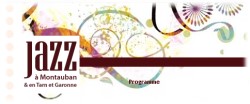 The elegant city of Montauban (82 Tarn-et-Garonne, Occitanie) gets its streets filled with music from 20 – 23 June 2024 with its Festival Montauban en Scènes (see www.montauban-en-scenes.fr) and there will be other attractions such as the opportunity to taste the wines of the Cotes de Brulhois AC which come from just south of Agen (47 Lot-et-Garonne, Nouvelle-Aquitaine) and are red wines based on Tannat, Malbec, Merlot, Cabernet and Fer Servadou grapes – a potentially rustic blend which can produce some seriously good reds.
The elegant city of Montauban (82 Tarn-et-Garonne, Occitanie) gets its streets filled with music from 20 – 23 June 2024 with its Festival Montauban en Scènes (see www.montauban-en-scenes.fr) and there will be other attractions such as the opportunity to taste the wines of the Cotes de Brulhois AC which come from just south of Agen (47 Lot-et-Garonne, Nouvelle-Aquitaine) and are red wines based on Tannat, Malbec, Merlot, Cabernet and Fer Servadou grapes – a potentially rustic blend which can produce some seriously good reds.
Stay in a converted 17th Century abbey at the Hotel Abbaye des Capucins near the centre of Montauban with its own bistro, courtyard and swimming pool.
Montauban built mainly of a reddish brick, stands on the right bank of the Tarn River at its confluence with the Tescou.
The town’s fortifications have been replaced by boulevards beyond which extend numerous suburbs, while on the left bank of the Tarn is the suburb of Villebourbon, which is connected to the town by a remarkable bridge of the early 14th century. This bridge is known as Pont Vieux (i.e. “Old Bridge”). King Philip the Fair of France officially launched the building of the bridge in 1303 while on a tour to Toulouse. The project took 30 years to complete, and the bridge was inaugurated in 1335. The main architects were Étienne de Ferrières and Mathieu de Verdun. It is a pink brick structure over 205 metres (224 yards) in length, but while its fortified towers have disappeared, it is otherwise in a good state of preservation. The bridge was designed to resist the violent floods of the Tarn River, and indeed it successfully withstood the two terrible millennial floods of 1441 and 1930. The bridge is a straight level bridge, which is quite unusual for Medieval Europe, where lack of technological skills meant that most bridges were of the humpback type.
The Musée Ingres, on the site of a castle of the Counts of Toulouse and once the residence of the bishops of Montauban, stands at the east end of the bridge. It belongs chiefly to the 17th century, but some portions are much older, notably an underground chamber known as the Hall of the Black Prince (Salle du Prince Noir). It comprises most of the work (including his “Jesus among the Teachers of the Law”) of Jean Ingres, the celebrated painter, whose birth in Montauban is commemorated by an elaborate monument. It is the largest museum of Ingres paintings in the world. The museum also contains some sculptures by famous sculptor Antoine Bourdelle, another native of Montauban, as well as collections of antiquities (Greek vases) and 18th and 19th ceramics.
The Place Nationale is a square of the 17th century, entered at each corner by gateways giving access to a large open space surrounded by pink brick houses supported by double rows of arcades.
The préfecture is located in the palace built by the intendant of Montauban (the equivalent of a préfet before the French Revolution), and is a large elegant 18th century mansion, built of pink bricks and white stone, with a steep roof of blue gray slates, in a style combining northern and southern French styles of architecture.
The chief churches of Montauban are the cathedral, remarkable only for the possession of the “Vow of Louis XIII”, one of the masterpieces of Ingres, and the church of St Jacques (14th and 15th centuries), dedicated to Saint James of Compostela, the façade of which is surmounted by a handsome octagonal tower, the base of which is in Romanesque style, while the upper levels, built later, are in Gothic style. wikipedia
![]() Hire a car and get best rates from Toulouse through Rentalcars Connect
Hire a car and get best rates from Toulouse through Rentalcars Connect
